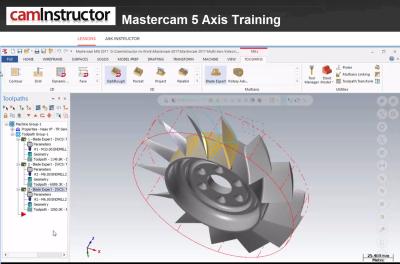
The technology educators at CamInstructor Inc. announce new, online CNC programming training courses of interest to manufacturers. The course offerings are designed for people brand new to CNC machine tool programming, as well as for more experienced programmers who may need a refresher or get up to speed on the latest software release.
The brand new course “bundle,” called CamInstructor Premium, includes comprehensive training in Mastercam CAD/CAM software, SOLIDWORKS CAD software, CNC Programming and instruction on Setting Up and Operating Haas CNC Machines. In addition to the published lessons, there are also videos, quizzes to test comprehension at certain milestones, and access to an instructor for ongoing assistance when questions surface. Further, the “student” has the option to earn a Certificate for certain courses. They also have access to all of the purchased materials for a full year and can download the documents for printing and saving for as long as desired.
“Our customers like so many things about acquiring CNC programming training online,” said CamInstructor’s Sheila Weidinger. “They enjoy learning at their own pace while they are relaxed and receptive. They don’t have to take on the expense or time to be away from the shop for intensive off-site training where ‘information overload’ can easily happen. They often cite an 80 percent savings in training costs. They appreciate having access to all of the materials for an entire year. And, the interaction with an instructor distinguishes CamInstructor from other online training providers.”
In addition to the new CamInstructor Premium bundle, the company also offers a Mastercam Premium bundle and a Mastercam Standard bundle. The Mastercam bundles include Mill 2D, Mill 3D, Lathe, 4-Axis, 5-Axis, Wire and Solids. The Standard Bundle has everything that the Premium Bundle has except the instructor access and testing. CamInstructor has been offering the Mastercam Training Bundles for the past 10 years and have helped train over 2,000 people to learn Mastercam.
“We have several cases in which an employer purchases courses for his employees,” said Weidinger. “In those instances, we offer a quantity discount. Some employers offer time for this training on the job site, while others compensate their employees to learn at home. We have included the Mastercam Home Learning Edition for downloading. When an employer makes the purchase, he or she can monitor the employee’s progress through the coursework.”
Contact Details
Related Glossary Terms
- computer numerical control ( CNC)
computer numerical control ( CNC)
Microprocessor-based controller dedicated to a machine tool that permits the creation or modification of parts. Programmed numerical control activates the machine’s servos and spindle drives and controls the various machining operations. See DNC, direct numerical control; NC, numerical control.
- computer-aided design ( CAD)
computer-aided design ( CAD)
Product-design functions performed with the help of computers and special software.
- lathe
lathe
Turning machine capable of sawing, milling, grinding, gear-cutting, drilling, reaming, boring, threading, facing, chamfering, grooving, knurling, spinning, parting, necking, taper-cutting, and cam- and eccentric-cutting, as well as step- and straight-turning. Comes in a variety of forms, ranging from manual to semiautomatic to fully automatic, with major types being engine lathes, turning and contouring lathes, turret lathes and numerical-control lathes. The engine lathe consists of a headstock and spindle, tailstock, bed, carriage (complete with apron) and cross slides. Features include gear- (speed) and feed-selector levers, toolpost, compound rest, lead screw and reversing lead screw, threading dial and rapid-traverse lever. Special lathe types include through-the-spindle, camshaft and crankshaft, brake drum and rotor, spinning and gun-barrel machines. Toolroom and bench lathes are used for precision work; the former for tool-and-die work and similar tasks, the latter for small workpieces (instruments, watches), normally without a power feed. Models are typically designated according to their “swing,” or the largest-diameter workpiece that can be rotated; bed length, or the distance between centers; and horsepower generated. See turning machine.
- milling machine ( mill)
milling machine ( mill)
Runs endmills and arbor-mounted milling cutters. Features include a head with a spindle that drives the cutters; a column, knee and table that provide motion in the three Cartesian axes; and a base that supports the components and houses the cutting-fluid pump and reservoir. The work is mounted on the table and fed into the rotating cutter or endmill to accomplish the milling steps; vertical milling machines also feed endmills into the work by means of a spindle-mounted quill. Models range from small manual machines to big bed-type and duplex mills. All take one of three basic forms: vertical, horizontal or convertible horizontal/vertical. Vertical machines may be knee-type (the table is mounted on a knee that can be elevated) or bed-type (the table is securely supported and only moves horizontally). In general, horizontal machines are bigger and more powerful, while vertical machines are lighter but more versatile and easier to set up and operate.
